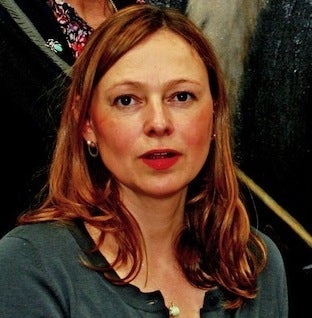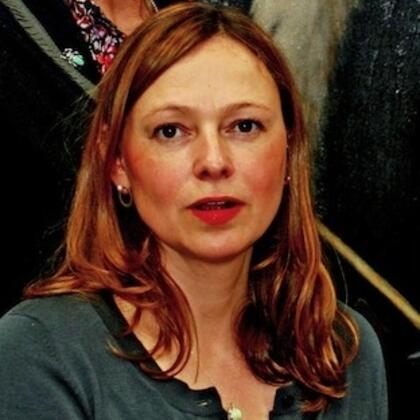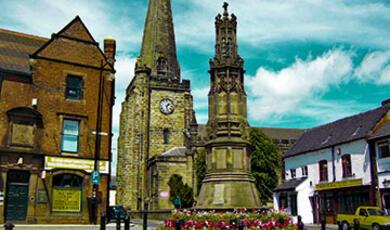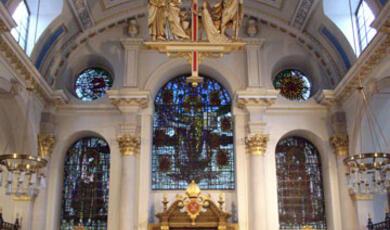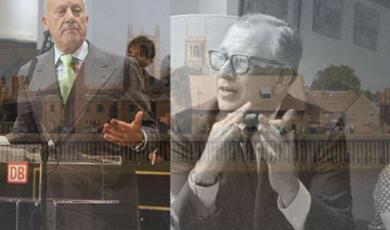The Faces of a King: New research on portraits of Henry VIII
Share
- Details
- Transcript
- Audio
- Downloads
- Extra Reading
The context of royal portraiture in its early evolution, and the many different portraits produced of Henry in his lifetime. This lecture will look at the context of royal portraiture in its early evolution, and the many different portraits produced of Henry in his lifetime. Why has Holbein's often-copied portrait stood the test of time?
Dr Tarnya Cooper is Curator of Sixteenth-Century Collections at the National Portrait Gallery.
Download Transcript
The Faces of a King:
New research on portraits of Henry VIII
Tarnya Cooper,
Curator of Sixteenth Century Collections, National Portrait Gallery
Introduction
Slide: 3 Henry portraits
This talk considers the contexts of production in relation to portraits of Henry VIII and examines in detail three paintings that have recently been the subject of detailed technical analysis belonging to the National Portrait Gallery (shown on the screen date from 1520s & two others from c. 1535 - to identify these Im going to call them Henry in the red and Henry in the Gold tunic).
This talk asks two questions; firstly what can the early portraits of Henry (mostly by Netherlandish artists) tell us about the early visual representation of Tudor kingship and its audiences. And because this early phase of Henry's portraiture is less well known I going to spend some time on these early pictures. But in the last part of the talk (PRESS SLIDE: Holbein) we will look at why was the version of Henry's VIII portrait designed by Hans Holbein the younger, so enduringly successful? (painted originally for Whitehall Palace in 1537, but as we will see - many, many other full-length version were made).
Slide: Cons studio:This research took place as part of a five year research project called Making Art in Tudor Britain based at the National Portrait Gallery and I should say that as the art historian on this project, I am particularly grateful to my research colleagues in our Conservation team who (who really do all the hard spending months looking down microscopes, or chain to x-ray machines) and who carried out the technical work on these pictures. So, in order to engage with these paintings a material objects I will be showing a lot of images quite quickly and details of paint surfaces. (these were things devised, created, physically handled and mishandled, loved or disguarded by 16th century people - so technical evidence can tell us something about this, but critically, it can also tell us about dating.
Slide Henry 6th versions: But before we talk about that, we need to know something more about the way Tudor painters workshops operated.Evidence of the way painters workshops produced portraits of royal sitters for an emerging market is found in these 3 portrait dating from the 1530s or 1540s of Henry 6th. These 3 surviving examples, all from the same workshop show that the same composition could be purchased with different coloured backgrounds and slightly different decoration on the jewellery. Did buyers perhaps stipulate which colours they required - perhaps even to fit in with other domestic colour schemes and how much gold was used in the decoration? We don't know, but these versions indicate this was a possibility. Establishing who painted these early images is virtually impossible as they were produced by sizable English workshops as a collaborative production (one craftsman prepares the panel, another draws out design from a pattern, another paints in the coloured areas, another does the gilding etc.). Current technical evidence reveals that this group are almost certainly by the same workshop. Yet attempts to determine between workshops are fraught with difficultly as patterns were likely circulated. In the past art historians have gleefully attempted attribute works to particular artists or workshop at this date (for example this group has been called the 'cast shadow workshop'. But more and more we have come to realised that we don't have the tools to impose categorisation. It understandable why this has happened things often make sense only when they have names, but the game of attribution to specific artists has often served the art market, better than it has the historian.
Press slide: All Henry 8th, :
SO, to come back to portraits of Henry 8th, its clear that artistic practice at this period was more about the production of royal imagery as emblem, rather than the capturing likeness from life or the artistic ingenuity of the painter. Wealthy subjects wanted decorative items on walls that expressed -at a basic level - loyalty or to the crown, or perhaps conversely to made plain their own receipt of royal favours.
Although surviving evidence is random, it appears possible that such portraits of the king Henry VIII could be purchased either to order or off the peg in the same way. This view conflicts with Sydney Anglo's belief that portraiture was primarily produced for state purposes and would not have been seen, or even on comptemplated upon by the citizenry. Indeed, quite a large number of portraits of Henry survive from this period (XX ARE recorded as extant in the NPG archives HOW MANY?) But this is likely a fraction of what was originally produced as survival rates for oil paintings on wooden panels are very low, we estimate around 60% or more has been lost. (showing you a damaged picture here - most Tudor have significant paint loss)
Slide of evidence from inventories:
New archival evidence from inventories is fragmentary but does make clear that portraits of Henry were owned by people outside court circles. More research is needed but particularly in London inventories indicates that portraits of both Henry 7 and Henry 8th were occasionally on display in homes of the wealthy citizenry. For example in 1533 the Goldsmith Robert Amadas (d.1532) owned a portrait described as 'a tablet of king Henry vii', while the inventory of the alderman Sir Thomas Offley (d. 1582) lists alongside paintings of 'Lasarus' and the Queens arms (Elizabeth I), a 'pattern of King Henry' (probably Henry VIII) which hung 'in the little chamber over the woolhouse'.[1]
(We need to be cautious because the small numbers of surviving inventories extant don't provide a viable sample to make judgement about extent of ownership. All we can say is that there are some examples of ownership of royal portraiture in homes other than the nobility.)
Whole image: Henry VII - 4690 dating 1520s
This portrait almost certainly dates from the 1520s as can be confirmed by dendrochronology or tree ring dating. Stylistically, the handling tells us it is from a Anglo Netherlandish workshop, likely a Netherlandish émigré working in London.
Detail Describe: Much applied gold, Spanrels, Green background is probably meant to depict either embossed velvet or embroidered silk. It is not possible to identity an artist and although the composition is not hugely sophisticated, there are some very well painted passages of painting. It would have served it function as an emblem of loyalty to the crown provided a striking image which would have impressed contemporary viewers, perhaps particularly when seen from a distance.
Slide: Richard and Henry (royal collection)
So what can the king pose in this portrait tell us? He is shown in the process of removing a gold ring from his little finger of his proper right hand. This is a gesture of holding, placing or removing rings is seen in earlier portraits of plantegenant kings (Richard III and Edward 4th). The meaning of this gesture is not exactly clear it may not be restricted to the celebration of marriage (as much of the literature suggests) but likely also refers to the acceptance of authority of kingship or the action of bequeathing authority, for example upon noble servants. (Rings given and received as tokens of loyality).
Versions - x slides with private collection and Sutton place image
The portriat was perhaps one of a number produced at this date to meet a growing demand at court and among wealthy subjects and other similar, but no exact contemporary version of this type appears to have survived. These two portraits both use a similar face pattern with broadly similar dress and were probably painted for a courtiers and wealthy subjects. In the 1520s very limited numbers of portraits of other members of the court were on display, and the king could be recognized by both being portrayed in life size format and wearing lavish cloth of gold. The placing of the portrait in an architectural focal point would have also been important. Perhaps in order to meet a wider demand for his image, exact likeness was a secondary issue.
Slide: Other versions Yet although these portraits might seem to derive from an established pattern technical analysis can show that in both the Nat Port Gallery portrait and two other similar versions (shown here) these different artists were uncertain of how to construct the composition. Both have had alternations the composition at Press slide. (Point out).
Slide: Anglesey abbey version, xray and an earlier portrait
It seems possible that these portraits started out with one template of one likeness and adapted it over time. For example in the Anglesey Abbey portrait the hair was originally longer, like the earlier portrait variously identified as Henry or Arthur. (Also changes in the face of the other image).
Slide: NPG Henry and x-ray In the NPG version The original design for the face was very different from the finished painted surface which indicates a search for a composition and changes of direction.
Slide Henry face and detail: At some point during the painting process the shape of Henry's face was altered: The nose was begun in a different place is larger extending further to the right.
Slide of Henry & Slide of Arthur
Thus the original facial features of the underdrawing are thinner and appear far more like existing the likenesses of Henry VII or possibly Prince Arthur. The point here is that facial likeness of individuals did not seem to be fixed in portraiture, and templates for kingship were more concerned with the appropriately grand costume, jewels and poses of authority.
Slide: Catherine of Aragon, c. 1520
A portrait at Lambeth Place previously identified as Catherine Parr has recently undergone technical analysis. The portrait can now be re-identified as Catherine of Aragon, on the basis of dress and likeness to other versions (most of which are later.)
Slide damage. The painting has suffered from several serious campaigns of over painting, The background is entirely overpainted, and the face and dress heavily retouched as this UV photograph illustrates.
Slide: Xray showing headdress: The background obscures the queen's long headdress other details.
Slide Henry and Catherine:
It would seem highly probably that this portrait was produced as a pendant to one of Henry VIII, perhaps one of a type similar to NPG 1520s portrait. There is some evidence from microscopic analysis of remnants of framing spandrels that also appear beneath the over paint on Catherine's portrait.
Slide: Details - underdrawing shows use of a pattern, but with some change, position of chain altered.
Slide: Hanging Mechanism Unusually, the portrait is in its original frame, which provides evidence of how it was originally presented and hung. Holes at the back of panel show that cord or perhaps even wire was passed through the back to allow the picture to be hung on a nail. This type of hanging device is seen in the back of the portrait of Lady Dacre dating from the 1550s where a small portrait of her husband is seen hanging from a ribbon.
Portrait of Henry VIII - 1376 & 3638 both c.1535-40
These two alternative compositions of Henry by different Anglo-Flemish workshops again show a different image of the king from Holbein's Whitehall mural. It would seem probable the original patterns for both these image predates the Whitehall cartoon, and they perhaps date from around 1535. Although these two compositions are similar share the consistent features of his small eyes and mouth, long narrow nose and reddish beard, the costume and poses are distinct. It is true that once a facial pattern had been established it could be altered without the need to request sittings from the king, but whether they could be altered this radically is questionable regardless of sittings and the need for at least revised detailed drawings seems likely.
Portrait of Henry VIII - 3638 c.1530s-40
Unusually the provenance of portrait of Henry with gold tunic provides possible evidence of early ownership. This picture can be linked to Henry VIII's Chaplain Anthony de Bellasis, who was granted Newburgh Priory, Yorkshire after the dissolution of the monasteries (from where the picture was purchased by the NPG). We can of course only speculate if this was commissioned by the Chaplin or purchased by his heirs at a later date. But as court servant, minor member of the gentry and beneficiary of the Henry's policy of dissolution it certainly would have been entirely appropriate for him to own such an image.
Slide: Details
The portrait is very finely painted, but as with virtually all 16th century portraits it has suffered from losses and abrasion over time - gold tunic probably once had red glaze to create reddish cloth of gold rather the current flat appearance.
Slide: Horenbout min: The similarity to the dated miniature by Lucus Horenbolte showing Henry aged 35 ie. c.1525 makes it likely the earlier miniature is a pattern for this type, which is then adapted in different ways by different studios for both manuscripts and oil paintings - simply painted open features
Slide: Hardwick and Woburn Abbey. The existence of a range of images with a similar compositions show how costume formats and face patterns were subtly adapted to produced other images without the need for sittings from the king.
Slide: Henry and Joss van Cleve c.1535
The composition is also broadly similar to another important portrait of Henry considered to be by Joos van Cleve painted around 1535. It seems unlikely that the that NPG picture has not been directly adapted from it as the face pattern, costume proportions and angle of the head are quite different. The conventional thinking about the van de cleve portrait is that it was painted abroad perhaps from another source, probably without the artist ever seeing the king. However, this picture is in poor condition and the face is heavily abraded features which makes it very difficult to assess its original appearance, but the face was probably more particularised than appears today.
Slide red tunic and frame NPG 1376 Analysis of the portrait of Henry with red tunic by dendrochronology suggest the wood dates from after 1520s supporting a production date of the 1530s-4. Both portraits show evidence of engaged frames, and the frame for the portrait Henry with the Red tunic is still extant. Such frames usually contained inscriptions with the sitters name and ensured the picture as ready made to hang upon a wall and easily identifiable.
Slide framing device:
This method of framing involved the frame being applied prior to painting stage and is common with most other portraits of this date. (see unpainted edge which slotted into pre-existing frame before painting begun).
Slide: versions of Henry in red tunic
The composition exists in several versions and in particular the recent research has shown that this portrait the Society of Antiquaries is a reduced scale version from the same workshop. A recent tracing of the facial features showed that the same pattern was used for both versions as all features correspond in position and relative proportion.
Slide: hat detail Both the NPG and society of antiquities portraits of Henry have a reasonable distinctive technique which indicates that magnification was used to apply details to the paint surface. Where individual hairs can be seen at the edge of the hat, some of the black paint has been flicked downwards into the hair. This is very precise, and is not visible to the naked eye and can only be seen under the microscope. For all the skill of Netherlandish painters few could match with Hans Holbien, another émigré who returned to England for a second visit in 1532.
Holbein cartoon and copies
As interesting as these Anglo Flemish portraits of Henry are they lack the skill, draughtsmanship and ultimately dynamism of Holbein's work. The time spent considering these images shows for a contemporary viewer how and why Holbein's portrait was so outstanding. Holbein's Job in re branding Henry's image began with the Whitehall cartoon. Holbein had hitherto apparently not been required to paint portraits of the King, but was engaged in decorative work including designs for fountains and fireplaces.
Slide: Holbein cartoon and Copy
The only the left side of the cartoon survives and a copy made in 1667 by Van Leemput showing what it would have looked like in whole when in situ at Whitehall.
Slide: Henry VIII - 1537 (Museo Thyssen Bornemisza, Madrid)The drawings made at same sittings which produced the cartoon for whitehall also allowed Holbein to produced other smaller portable versions of the king. This remarkable portrait (now in Madrid) uses the same pattern with slightly different costume and was clearly painted to closely examined.
Copies: Both the full length and the head and shoulders portriats spawned many copies, These full length portrait directly from the pattern of the cartoon were successfully reproduced over a long period. These were identified by Liverpool museum through dendrochronology in 2003 as dating from 1540s, 1560s & 1580s Holbein's images thus became the most enduring image of the king for the next four hundred years and copies were still being made into the 17th century. Why did this happen? Because in contrast to the earlier Netherlandish portraits it showed Henry as an invincible ruler, and pulled off the trick of depicting the king a man both tough and bullish, but also elegant, supremely wealthy and astute. It did this because on the walls of successive generous across Europe, it was the portrait that fitted the best fitted the extraordinary history narrative of a man who married six times, executed two wives and numerous courtiers, sacked the monestries and destroyed the catholic church in England.
© Tarnya Cooper, 1 October 2009
[1] Thomas Offley: National Archives, Prob 2/423 & Foister, 1981, p.277.
This event was on Thu, 01 Oct 2009
Support Gresham
Gresham College has offered an outstanding education to the public free of charge for over 400 years. Today, Gresham plays an important role in fostering a love of learning and a greater understanding of ourselves and the world around us. Your donation will help to widen our reach and to broaden our audience, allowing more people to benefit from a high-quality education from some of the brightest minds.


 Login
Login
